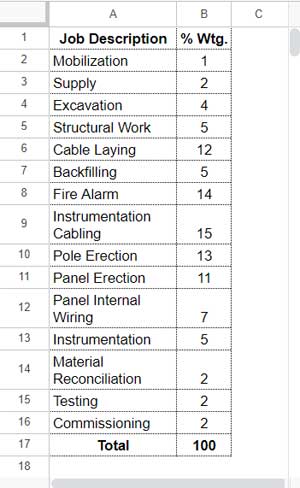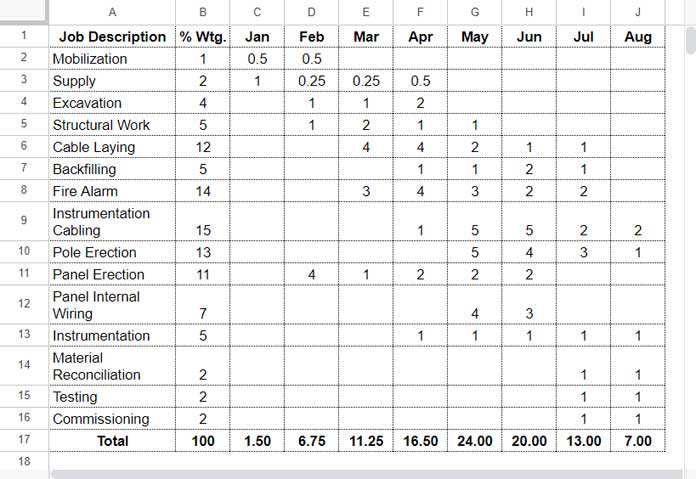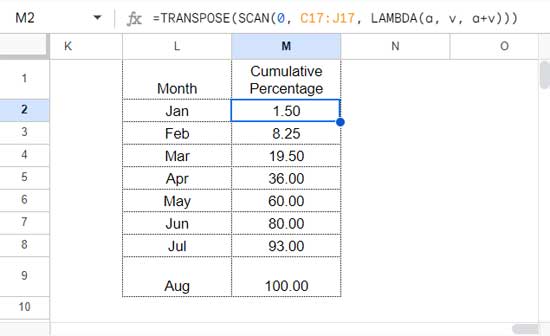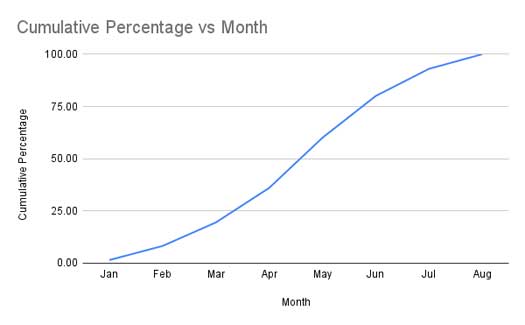An S-curve chart is a line chart in Google Sheets that is used for the graphical representation of cumulative data over time. It tracks progress or growth against a schedule and is widely used in project management.
In project scheduling, the allocation of percentage weightage for tasks will be lower at the beginning, peak in the middle, and lower again at the end. This pattern is typical for progress or growth. When such data is plotted using a line chart, it will resemble the letter “S”.
In the initial stage, progress will be slow due to various preparations such as material procurement, manpower arrangement & allocation, site clearance, etc. Progress accelerates gradually, reaching its peak in the middle, and then slows down as completion nears.
To create an S-curve chart, you must know how to format the data in Google Sheets.
Sample Data Preparation for Creating an S-Curve in Google Sheets
Unlike other charts, creating an S-curve in Google Sheets requires specific data structuring. Let’s understand this in detail in layman’s terms.
Distributing Percentage Weightage Across Items
Suppose I have a job involving the completion of substation work. This job may include various activities such as mobilization, supply of materials, cabling, panel erection, testing, and finally, commissioning activities.
To schedule this job and monitor it with an S-curve, a planning person typically assigns 100% weightage to the total job and then distributes this weightage among all the involved activities.
The distribution of weightage depends on several factors, such as manpower availability & requirements, the time needed for each task, priority, clearance, material availability, etc. Next, they assign a time frame for completing the job.
You can see the job descriptions in column A and the percentage allocations in column B.

Distributing Percentage Weightage Over the Timeline
Now that we have the percentage weightage for each item, we should now plan the duration required to complete each task.
For shorter projects, such as one month, you can distribute the weight daily. For longer projects, it might be better to distribute it weekly or monthly.
In this example, my project duration is 8 months from Jan’24 to Aug’24, and I am distributing the percentage weightage monthly. This means determining how much percentage should be achieved each month.
Please see this distribution in columns C to J.

Now, we will proceed to the most important step in creating the S-curve in Google Sheets, which is formatting the data for the chart.
Cumulative Data for S-Curve
This is the final step of formatting data for creating the S-curve in Google Sheets.
We need a table that contains the months in one column and the running total of each month’s percentage weightage in another column.
You can enter the month names (Jan to Aug) manually in a column or use a formula to fetch them. I am using the following formula in cell L2 to transpose the month names from C1:J1:
=TRANSPOSE(C1:J1)Next, we want the running total of each month’s scheduled percentage in C17:J17 in column M, next to the month names. For that, we can use the following formula in cell M2:
=TRANSPOSE(SCAN(0, C17:J17, LAMBDA(a, v, a+v)))
When you use this formula, replace C17:J17 with the reference to each month’s column total. You can read more about this formula in my SCAN function guide.
In cells L1 and M1, enter the field labels “Month” and “Cumulative Percentage,” respectively.
We are all set to create the S-curve now.
Steps to Create an S-Curve Chart in Google Sheets
Since we have properly arranged data, creating an S-curve is easy in Google Sheets.
Here are the step-by-step instructions:
- Select the range L1:M9.
- Click Insert > Chart.
- Within the Chart Editor sidebar panel, under the Setup tab, select Smooth Line Chart under the Chart Type. This will create the S-curve based on the selected data.
- There are several customization options under the Customize tab within the Chart Editor, such as turning the legend on/off, title customization, etc.

That’s all about creating an S-curve in Google Sheets.
Note: You can enter the actual monthly achieved cumulative percentage weightage of each task in N2:N9 and track your progress against the schedule as well.
Resources
Here are a few related resources regarding project management:
- Create Gantt Chart Using Formulas in Google Sheets
- Basic GANTT Chart in Google Sheets Using Stacked Bar Chart
- Create a Gantt Chart Using Sparkline in Google Sheets
- Steps to Create a Weekly or Monthly Progress Chart in Google Sheets
- How to Create a Percentage Progress Bar in Google Sheets
- Split a Task in a Custom Gantt Chart in Google Sheets
- Multi-Color Gantt Chart in Google Sheets
- Days Remaining in Gantt Chart in Google Sheets
- Track Remaining Days in Tasks with Sparkline Gantt Charts
- Date Filter in Gantt Chart in Google Sheets






















Hi Prashanth,
Great article! Thank you very much for the detailed tutorial. Could I have a template of yours on Google Sheets?
Thank you!
Hi there,
Thank you for your kind words! I’m glad you found my tutorial helpful. I do have a template, and I’d be happy to share it with you. You can find it here: Sample Sheet.
I hope you find it useful!
Best,
Prashanth
Thanks a lot, I have enjoyed the tutorial. I request for a tutorial in Ms project in form of a PDF file. Thanks, It will be very grateful.
Francis olem
Hi, Francis,
Nowadays I am fully concentrated on Google Sheets and not even have a working copy of MS Project.
It’s glad that you enjoyed this tutorial!
Thanks for the drop by.
Best,